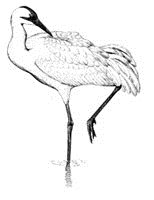North American Crane Working Group

Proceedings of the North American Crane Workshop
Date of this Version
2023
Document Type
Article
Citation
Proceedings of the North American Crane Workshop (2023) 16: 1–13
Abstract
During spring migration, more than 1 million sandhill cranes stage along the Platte River in central Nebraska. Appropriate river flows can support ideal depths for roosting and provide protection from terrestrial predators. Cranes and other waterbirds occasionally roost outside of the river channel or reduce diurnal activity therein but conditions under which this occurs remain poorly defined. Despite the ability to influence flows in this highly managed river system, many hydrological factors remain outside of managers’ control. We examine the proportion of sandhill cranes detected in nonriverine habitat during weekly aerial surveys from mid-February to mid-April from 2016 to 2023. We compared gamma family Generalized Linear Models predicting off-channel relative abundance during surveys using Akaike Information Criterion corrected for small sample sizes to assess the phenological and hydrological conditions associated with increased terrestrial occurrence. The proportion of cranes off-channel peaked when crane densities were ostensibly highest near midmigration. Incidents of icing and increased daily variation in river flows were positively associated with off-channel relative abundance. Operations appreciably amplifying daily river fluctuations may decrease the suitability of roosting conditions for cranes. Top models included weekly precipitation and drought occurrence, showing sandhill cranes respond differently to short-term and long-term changes in hydrological conditions. Short-term wetter hydrological conditions provide more standing water for alternative roosting locations in palustrine wetlands, whereas prolonged drought negatively affects riverine roosting habitat. High flows were not associated with off-channel roosting, but we only observed 1 instance where mean flows exceeded 5,000 cubic feet per second. In this instance, a large proportion (~40%) of cranes were detected off-channel.


Comments
Copyright 2025, North American Crane Working Group. Used by permission